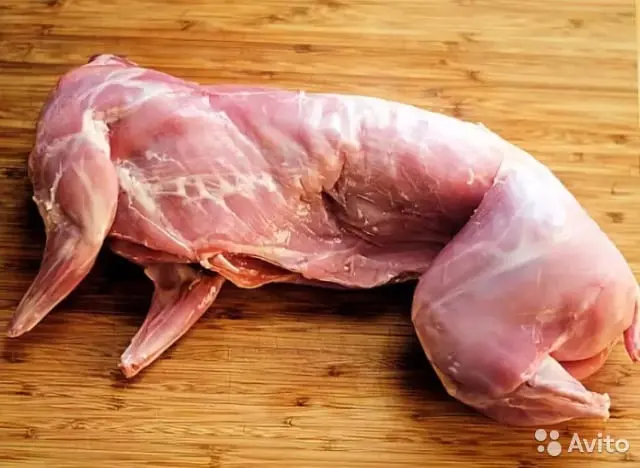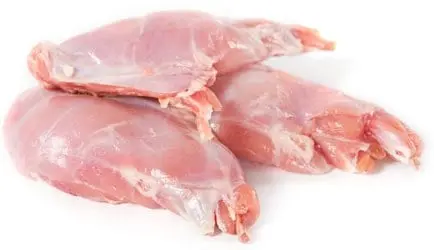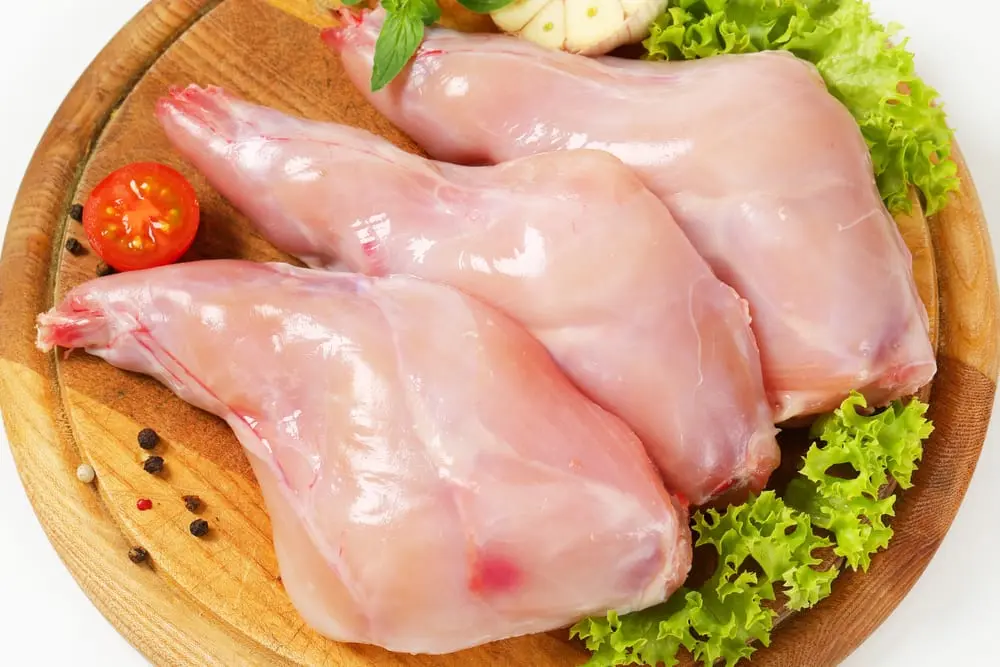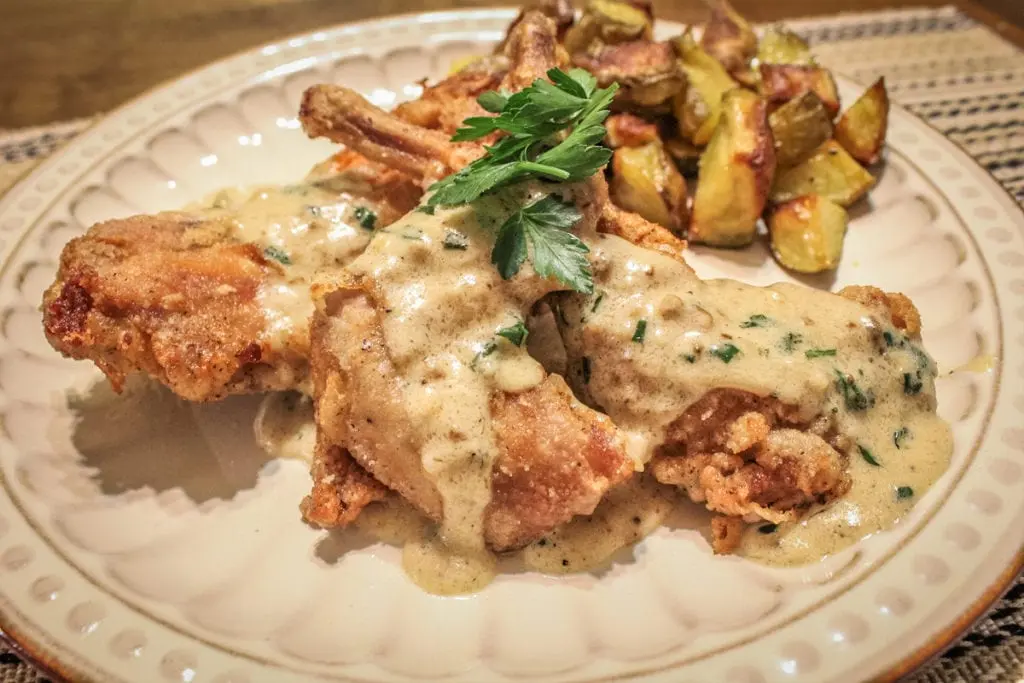Contents
Description
The amazing taste and nutritional qualities of rabbit meat have been known for a long time. Archaeologists have found evidence that rabbits were bred in ancient Rome. The tradition continues today as rabbit meat is a valuable source of protein with low fat levels and an ideal ratio of omega-6 to omega-3 fatty acids.
Rabbits reproduce and grow so rapidly that healthy females can produce over 300 kg of meat annually. In addition, these animals use feed so efficiently that they only need 2 kg of feed to produce half a kilogram of meat.

In order to assess the degree of their productivity, we note that a cow needs to eat 3.5 kg of feed to produce the same amount of meat. On top of that, the rabbit consumes those forage plants that are not used by humans. Thus, he not only relieves human land of useless plants, but also turns them into meat.
The lion’s share of the market belongs to the meat of rabbits raised on farms, since their meat, in contrast to the meat of wild rabbits, is more tender and does not have the characteristic aftertaste of game. Because rabbits are quite unpretentious, keeping them does not involve any incredible effort, so breeding rabbits is incredibly profitable and cost-effective.
Rabbit meat composition

- Caloric value: 198.9 kcal
- Water: 65.3 g
- Proteins: 20.7 g
- Fat: 12.9 g
- Ash: 1.1 g
- Vitamin B1: 0.08 mg
- Vitamin B2: 0.1 mg
- Vitamin B6: 0.5 mg
- Vitamin B9: 7.7 mcg
- Vitamin B12: 4.3 mcg
- Vitamin E: 0.5 mg
- Vitamin PP: 4.0 mg
- Choline: 115.6 mg
- Iron: 4.4 mg
- Potassium: 364.0 mg
- Calcium: 7.0 mg
- Magnesium: 25.0 mg
- Sodium: 57.0 mg
- Sulfur: 225.0 mg
- Phosphorus: 246.0 mg
- Chlorine: 79.5 mg
- Iodine: 5.0 mcg
- Cobalt: 16.2 mcg
- Manganese: 13.0 mcg
- Copper: 130.0 μg
- Molybdenum: 4.5 mcg
- Fluoride: 73.0 μg
- Chromium: 8.5 mcg
- Zinc: 2310.0 μg
How to choose the right rabbit
It is good to buy a rabbit, on the carcass of which furry paws, an ear or a tail are left, which is a guarantee that you are purchasing a rabbit. Some unscrupulous sellers may sell cats that look very similar to a rabbit under the guise of rabbit meat. In addition, when buying, you need to pay attention to the color of the carcass, it should be light in color without extraneous bruising and smell good.
If you don’t trust mass production, then you can easily start breeding rabbits yourself, since keeping and caring for them is quite an economical activity.
10 benefits of rabbit meat

- Diet rabbit meat, the benefits of which have been proven by medicine, are distributed mainly among young mothers, adherents of a healthy diet, athletes who want to lose weight and people with chronic diseases.
- Everyone finds their own advantages in it. For athletes, this is a valuable protein, for young mothers, the best complementary food for children, those who lose weight appreciate low calorie content, and for some patients this is the only type of meat diet that is available for consumption.
- Understanding the question of what rabbit meat is, benefit or harm, we will try to find an objective assessment and correlate all the pros and cons. Let’s list the useful properties of rabbit meat:
- When an animal is raised until the age of seven months, its body does not assimilate particles of heavy metals, strontium, pesticides and herbicides. Even when ingested with food, the elements are not deposited in the carcass.
- This property is especially useful for cancer and rehabilitation after radiation exposure.
- The product reduces the level of radiation received.
It is close in composition to human cells. Thanks to this, the product is absorbed by 96% (beef by 60%). This beneficial property is actively used by athletes to build muscle mass. They get almost completely digestible protein from food. - Compared to beef and pork, rabbit meat has the highest protein content – 21% and the lowest fat content – 15%.
- The low content of sodium salts makes it possible to receive the benefits of rabbit meat in the diet. With continued use, the low calorie content of the product stimulates the normalization of fat and protein metabolism.
- The abundance of lecithin with a minimum of cholesterol makes the product indispensable for the prevention of atherosclerosis.
- Helps regulate blood glucose.
A variety of micro, macronutrients and vitamins:
- Fluorine
- B12 – cobalamin
- Iron
- B6 – pyridoxine
- Manganese
- C – ascorbic acid
- Phosphorus
- PP – nicotinoamide
- Cobalt
- Potassium
- how is rabbit meat useful?
The listed facts confirm that the benefits of rabbit meat are undeniable.
Rabbit meat harm

Despite all its useful properties, rabbit meat also has a number of contraindications that do not depend on gender and age:
in the presence of arthritis and psoriasis, excess nitrogenous compounds accumulate in the joints;
exceeding the age limit can lead to hydrocyanic acid poisoning.
Rabbit Meat Cooking Tips
In the process of cooking rabbit meat, it is worth adhering to several rules: Individual approach to cutting the individual parts of the carcass: quartering the breast, cutting the paws at the joints, separating the back part just above the paws.
Use sauce to compensate for the lack of fat. Marinate meat cuts – in itself, it is quite dry. Fry and bake – no more than 30 minutes.
Simmer – one to three hours using a small fire. Important! Rabbit meat does not like high temperatures – under their influence, useful qualities are lost.
Overall, rabbit meat has a ton of health benefits. If you do not exceed the permissible daily allowance, the product will strengthen the body and make you healthy and full of energy, and the exquisite taste of meat will only bring pleasure.
Rabbit in sour cream and garlic sauce

Ingredients (for 8 servings)
- Rabbit – 1 pc.
- Sour cream – 200 g
- Bulb onions – 2 pcs.
- Flour – 4 tablespoons
- Butter – 100 g
- Bay leaf – 2 pcs.
- Pepper mixture – 1 tsp
- Garlic – 2-3 cloves
- Salt to taste
Preparation
- Cut the rabbit carcass into small pieces. Wash and dry. Season with salt and pepper. Mix.
- Peel and wash the onion, chop finely.
- Peel the garlic. Crush in a garlic.
- Then roll each piece in flour.
- Preheat a frying pan, add oil. Put the meat in the heated oil.
- Fry the meat on all sides until golden brown for 5-7 minutes.
- Place the fried meat in a cauldron.
- Put onion in a frying pan, fry, stirring occasionally, until golden brown for 2-3 minutes.
- Pour about 2 cups of cold boiled water into a frying pan, stir. Pour over the meat. Simmer over low heat until cooked for 30-40 minutes.
- Then put the bay leaf, sour cream, pour a little more water, so that the sauce completely covers the meat. Simmer for 10 minutes, over the lowest heat. Then add the garlic, mix and leave the rabbit in the sour cream sauce for 10-15 minutes.
- The rabbit in sour cream sauce is ready. Serve with a side dish of mashed potatoes, buckwheat porridge, pasta and be sure to pour the sauce.
Enjoy your meal!










